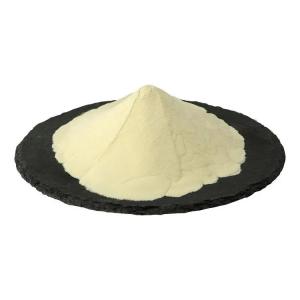Phosphatidyl serine is applied in whipped toppings.
Time:2025-08-08Whipped toppings are a popular addition to desserts, beverages, and various culinary creations. Their light, airy texture and sweet flavor make them a go-to for enhancing everything from pies and cakes to hot cocoa and coffee. While whipped toppings are typically enjoyed for their taste and texture, modern food innovation has introduced the possibility of infusing them with functional ingredients that offer added health benefits. One such ingredient is phosphatidylserine (PS), a phospholipid that supports cognitive function and overall brain health. This article explores the integration of phosphatidylserine into whipped toppings and its potential benefits for both food manufacturers and consumers.
What is Phosphatidylserine?
Phosphatidylserine is a naturally occurring phospholipid that is a key structural component of the membranes of cells, particularly in the brain. It plays a crucial role in maintaining the integrity of cell membranes and facilitating communication between cells. PS is abundant in the brain, where it supports various cognitive functions, including memory, learning, and focus. As we age, our body's levels of phosphatidylserine tend to decrease, leading to potential cognitive decline. Supplementing with PS has been shown to enhance cognitive performance, reduce stress, and support memory, making it a popular ingredient in supplements for brain health.
The Role of Phosphatidylserine in Whipped Toppings
Whipped toppings are typically made by aerating fats, such as cream or vegetable oil, into a light and fluffy consistency. These toppings are usually used for their texture and flavor rather than for any nutritional benefits. However, as the demand for functional foods increases, manufacturers are exploring ways to incorporate health-enhancing ingredients into everyday indulgences, and whipped toppings are no exception.
By infusing whipped toppings with phosphatidylserine, manufacturers can offer a product that supports cognitive health while still providing the delightful texture and taste consumers expect. The addition of PS to whipped toppings could help promote brain health without compromising on flavor, making it an appealing option for those looking to enhance their diets with functional ingredients.
Benefits of Phosphatidylserine in Whipped Toppings
Cognitive Health and Mental Clarity
One of the most notable benefits of phosphatidylserine is its ability to support cognitive function. As a key component of brain cell membranes, PS helps maintain brain health by improving cell communication and supporting the activity of neurotransmitters. By incorporating PS into whipped toppings, consumers can enjoy a sweet treat that may contribute to better focus, memory, and mental clarity, especially for those looking to improve their cognitive well-being.
Stress Reduction and Emotional Balance
Phosphatidylserine has been shown to play a role in regulating cortisol levels, a hormone associated with stress. Elevated cortisol levels can negatively impact cognitive function and mood, contributing to feelings of anxiety and fatigue. The addition of PS to whipped toppings could offer a convenient and enjoyable way to manage stress and support emotional balance, especially during stressful moments when a comforting snack is needed.
Brain Health Support for All Ages
While phosphatidylserine supplementation is often marketed to older adults experiencing age-related cognitive decline, younger individuals can also benefit from the cognitive-enhancing properties of PS. Adding phosphatidylserine to whipped toppings makes it easier for people of all ages to incorporate this beneficial nutrient into their diets without having to take supplements or pills. This can be especially beneficial for those who prefer not to consume traditional supplements but are still interested in supporting their brain health.
Convenient and Palatable Delivery Format
Whipped toppings are often enjoyed as part of desserts, hot drinks, and snacks. The inclusion of phosphatidylserine in these popular food items offers a convenient and palatable way for consumers to access the benefits of PS without altering their usual eating habits. Whether it's topping a slice of cake, dolloping it onto fruit, or adding it to a latte, the combination of pleasure and function makes this innovative food option appealing to a wide audience.
Appealing to Health-Conscious Consumers
As consumers become more aware of the impact of their food choices on long-term health, there is a growing interest in functional foods—foods that provide additional health benefits beyond basic nutrition. Whipped toppings with added phosphatidylserine represent a crossover between indulgence and health, offering a way to enjoy a treat while potentially supporting cognitive and mental health. This can make whipped toppings more appealing to health-conscious individuals who want to incorporate brain-boosting ingredients into their diets without giving up on flavor.
How Phosphatidylserine is Incorporated into Whipped Toppings
Phosphatidylserine is a fat-soluble molecule, which makes it compatible with whipped toppings that are primarily made from fats. The integration of PS into whipped toppings is usually achieved through emulsification, which ensures that the phospholipid is evenly distributed throughout the product. Manufacturers can use either soy- or sunflower-derived phosphatidylserine, depending on the desired formulation and consumer preferences.
The challenge of incorporating PS into whipped toppings lies in ensuring that it maintains its effectiveness while preserving the light, airy texture that makes these toppings so appealing. Fortunately, modern food science allows for the creation of stable emulsions that can keep the phosphatidylserine intact and ensure its bioavailability when consumed.
Additionally, flavor masking techniques may be used to minimize any potential bitterness that phosphatidylserine could contribute to the whipped topping. Natural sweeteners and flavorings, such as vanilla or chocolate, are often used to ensure that the final product is as enjoyable to eat as it is beneficial for the brain.
Potential Market and Consumer Appeal
The market for functional foods continues to expand as consumers seek out products that offer more than just basic nutrition. By introducing phosphatidylserine into whipped toppings, food manufacturers have the opportunity to tap into this growing trend and offer a product that appeals to health-conscious individuals, particularly those interested in cognitive health.
Moreover, whipped toppings are widely consumed in a variety of culinary applications, from desserts to beverages, making them an ideal delivery vehicle for phosphatidylserine. As more consumers become aware of the cognitive benefits of phosphatidylserine, whipped toppings containing PS may become a desirable option for those looking to support brain health in a fun and flavorful way.
Conclusion
Phosphatidylserine-enriched whipped toppings represent an exciting advancement in the world of functional foods. By adding this brain-boosting ingredient to a beloved food item, manufacturers can provide consumers with an enjoyable treat that also supports cognitive health, mental clarity, and emotional balance. As the demand for foods that offer both indulgence and health benefits grows, whipped toppings with added phosphatidylserine may become a staple in many households, offering a convenient and delicious way to nourish the body and mind simultaneously.


 CN
CN





